Firstly apologises for the length of code but I wanted to show it all.
I have an interface that looks like this:

When I change the third Option Menu to "List" I will add in the option to have 'n' values (not shown). I then require 'n' columns where the user can input their values.
I also have the problem where there may be 'n' amount of rows depending on a text file opened by the interface.
I am therefore wondering if it possible (as I'm having difficulties not repeating the same values in boxes and now I require 'n' columns) to add 'n' amount of rows and columns as my code shows with just adding 4 columns. I can read the amount of rows ok but have trouble returning all of these values depending on how many rows there are. So far I can do one row..
Thank you!
def numberwritten(number):
fg = number.get()
print fg
numbers = [StringVar() for i in xrange(4) ] #Name available in global scope. Need to add other rows?
for i in numbers:
i.trace('w',lambda a,b,c,n=i: numberwritten(n) )
def ChoiceBox(choice):
co_ord = str(frame_table.grid_size())
col, rows = map(float, co_ord.strip('()').split(','))
rows = int(rows)
if choice == "Fixed":
empty1.destroy()
#choice_frame.grid_forget()
tkMessageBox.showinfo("Message", "No optimisation, value fixed.")
elif choice == "List":
column = 7
for i in xrange(4):
choice_title = Label(frame_table, text='Value %g'% float(i+1), bg='white', borderwidth=0, width=10)
choice_title.grid(row=1, column=column+i, sticky="nsew", padx=1, pady=1)
boxes=[]
for i in xrange(4):
for j in range(2, rows):
box=Entry(frame_table,bg='white',borderwidth=0,textvariable=numbers[i], width=10, justify="center") # Here I'm having problems with rows
box.grid(row=j,column=column+i, sticky='nsew', padx=1, pady=1)
boxes.append(box)
box1,box2,box3,box4=boxes
elif choice == "Interval" or "Optimisation":
for i in xrange(2):
choice_title1 = Label(frame_table, text='Min Value', bg='white', borderwidth=0)
choice_title1.grid(row=0, column=column, sticky="nsew", padx=1, pady=1)
choice_title2 = Label(frame_table, text='Max Value', bg='white', borderwidth=0)
choice_title2.grid(row=0, column=column+1, sticky="nsew", padx=1, pady=1)
boxes=[]
for i in xrange(2):
box=Entry(frame_table,bg='white',borderwidth=0,textvariable=numbers[i])
box.grid(row=rows+1,column=i, sticky='ew', padx=1, pady=1)
boxes.append(box)
box1,box2,box3,box4=boxes
UPDATE: I've advanced slightly and the section in ChoiceBox which is now under a class Window: is ChoiceBox(self, choice), I have the following section where I need to change the commented line to accept 'n' amount of boxes.
column = 7
for i in xrange(self.number_boxes):
choice_title = Label(self.frame_table, text='Value %g'% float(i+1), bg='white', borderwidth=0, width=10)
choice_title.grid(row=1, column=column+i, sticky="nsew", padx=1, pady=1)
boxes=[]
for i in xrange(self.number_boxes):
for j in range(2, rows):
box=Entry(self.frame_table,bg='white',borderwidth=0,textvariable=numbers[i], width=10, justify="center")
box.grid(row=j,column=column+i, sticky='nsew', padx=1, pady=1)
boxes.append(box)
#box1,box2,box3,box4=boxes
I still however then have the problem of using numberwritten including the first few lines of code in original example to completely extract a list of values, preferably for each row.